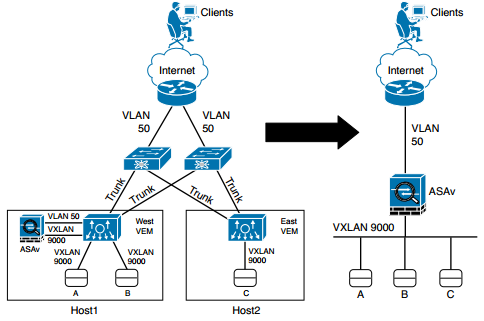210-451 CCNA Cloud CLDFND FAQ – Virtual Networking Services and Application Containers
Q1. Which of the following is not a data center networking service?
a. ADC
b. WAN acceleration
c. Network access control
d. Firewall
e. Intrusion prevention system
Q2. Which of the following are enhancements of vPath over service insertion methods such as VLAN manipulation, PBR, and WCCP? (Choose all that apply.)
a. Performance
b. Service chains
c. One-arm mode
d. Policy-based forwarding
e. Traffic offload
Q3. Which of the following are differences between VSG and ASAv? (Choose all that apply.)
a. VSG policies can be executed inside the hypervisor kernel.
b. ASAv policies can be executed inside the hypervisor kernel.
c. ASAv must analyze every packet from a connection.
d. VSG must analyze every packet from a connection.
e. VSG supports security policies with VM attributes.
Answer: a and c

Figure: ASAv Deployment Example
Q4. Which network operating system does CSR 1000V run?
a. NX-OS
b. IOS
c. IOS XR
d. IOS XE
e. ASR-OS
Q5. Which of the following is not a benefit applications gain from the use of ADCs?
a. Scaling
b. High-availability
c. Content switching
d. Clustering
e. Acceleration
Q6. Which of the following are required configuration elements when deploying server load balancing in Citrix NetScaler 1000V? (Choose all that apply.)
a. Stickiness table
b. Virtual IP address
c. Monitor
d. Servers
e. DNS
Q7. Which of the following is not a WAN acceleration method available on vWAAS?
a. TFC
b. Windows printing AO
c. DRE
d. PLZ
e. TFO
Q8. Which of the following virtual networking services support vPath? (Choose all that apply.)
a. VSG
b. CSR 1000V
c. ASAv
d. vWAAS
e. NetScaler 1000V
Q9. Which of the following solutions are components of Cisco Virtual Application Cloud Segmentation? (Choose all that apply.)
a. Nexus 1000V
b. PNSC
c. UCS Director
d. CSM
e. VSG
f. CSR 1000V
Q10. Which of the following are differences between three-tier and custom virtual application containers? (Choose all that apply.)
a. Additional security zones
b. Zone-based firewall
c. Number of application tiers
d. Use of VXLAN
e. Number of segments
More Resources